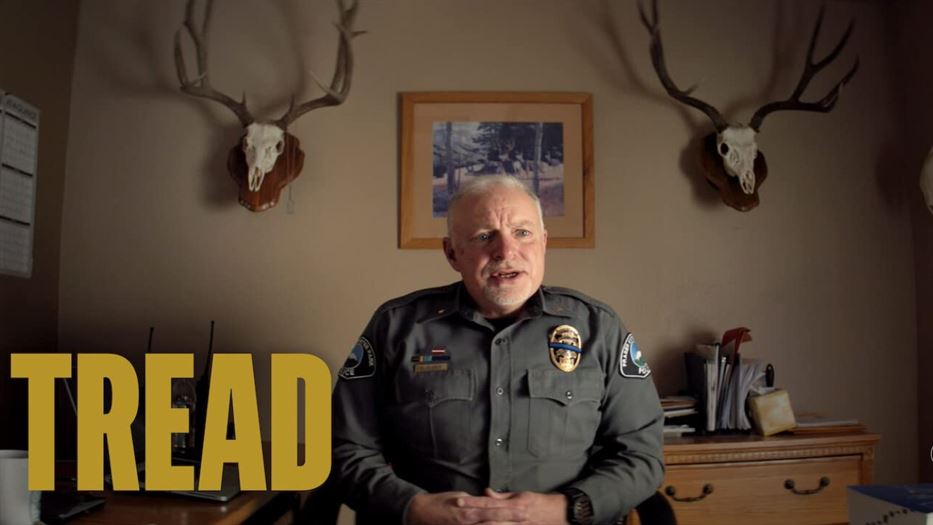If someone told you they were on a mission from God, would you believe them? What if they were driving an armored bulldozer?
“Tread” originally came out in 2019 and has been on Netflix since February of last year. There is a glut of true crime media on most streaming platforms, so it’s easy to overlook something as unique as “Tread” in the sprawling array of choices.
I heard about “Tread” as recently as a few weeks ago while listening to my favorite true-crime podcasts. “Last Podcast on the Left” and “My Favorite Murder” both mentioned the documentary. But after being available to stream for well over a year, why is it suddenly springing up now?
Before the events of June 4, 2004, welder and veteran Marvin Heemeyer recorded a verbal manifesto, which he offered up to the world on tape before setting out to fulfill what he saw as his divine purpose. In this way, his narrative is included in the myriad of testimonies upon which you may form your opinion of him.
This narrative often consists of his frenetic, rambling voice, first insisting that God made him act but later shifting to God inspiring him to act. A note taped to the wall in Heemeyer’s workshop reads, “Successful people do what unsuccessful people won’t do. Make a list. Plan your work. Work your plan.”
As America has witnessed the intensification of its own specific brand of nationalism, often improperly conflated with patriotism, this rhetoric has become synonymous with a very dangerous mindset. I’ve come across countless web pages and blog posts lauding Heemeyer as an “American hero,” a man who stood up to the tyranny of a bureaucratic establishment.
That might be part of Heemeyer’s mythos, but this same self-styled martyr also destroyed a playground that was full of children only moments before. True, he did not kill anyone but by some accounts, he certainly tried.

Marvin Heemeyer’s list of people with whom he felt he had a score to settle.
Photo courtesy of Zipper Bros Films
Heemeyer was clearly in need of help, but as his resentment grew he rejected it, revising the narrative afterward to make it seem as though he received none and was therefore further vindicated in his actions. A friend correctly remarks that he was a man who spent too much time alone.
When Heemeyer felt he had lost control of his situation, he aligned himself with an unstoppable, impervious machine. For him, the only way to rectify perceived injustice was to take everything from others.
“Tread” ultimately doesn’t give much room for consideration as to whether Heemeyer’s actions were justified. “No” is the easy answer. He caused millions of dollars in property damage and destroyed livelihoods.
But the first 30 minutes of “Tread” makes an equally compelling case on Heemeyer’s behalf, as do the testimonies of his sworn enemies. Upon my second viewing, I noticed a vacuity in their recollections, and a collective insistence on not recalling any active aggression toward Heemeyer.
The two narratives in “Tread” are at constant odds with each other; most likely there is some truth and falsehood in each. It’s up to the viewer to decide how much.

Directed by Paul Solet, “Tread” features an effective mix of personal interviews, recordings and dramatizations.
Photo courtesy of Zipper Bros Films
Heemeyer destroyed a community because he felt they purposefully impeded his progress to preserve their small-town hierarchy. This kind of frustration seems specific to America these days: the result of comparing the idealized American dream to the grim realities of social rigidity, pervasive bureaucracy and greed. The harder one clings to their belief in a system that never existed, the angrier they are when it is wrenched away.
The one thing that everyone, Heemeyer included, agrees on is that no one saw his final act coming.
One repeatedly shown photo captures Heemeyer smiling contentedly at the camera. The final time this picture appears, it is revealed that the bottom part of the photo was previously cropped out. In his hands is a .50 caliber rifle.
As the poster states, “Tread” must be seen to be believed. For any true-crime junkie in need of a tolerance break from serial killers or cults, “Tread” is a solid choice. But it is also a disturbing indictment of the illusory nature of American small-town life, and maybe there are lessons to be taken away from it.
Regardless, “Tread” reminds us that no fictional work can hope to be as terrifying as real life.



